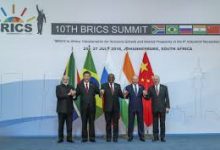Reserve Bank has raised the interest rate when the price prospects are stable or for that matter expected to fall; while the norm is, of course, that interest rates go up when prices are feared to rise. A report, for Different Truths.
It might not be obvious always why the gods behave the way they do. From their Olympian heights so much more could be visible than ordinary mortals. That also probably applies to the central banks.
Reserve Bank has raised the interest rate when the price prospects are stable or for that matter expected to fall; while the norm is, of course, that interest rates go up when prices are feared to rise.
It is really difficult to make out why a hike in the repo rate was announced at this point in time when the monetary policy statement almost argues that prices are by and large stable for now. The price inflation forecasts are also benign and should not be cause for worry. And yet, fearing a possible adverse price level development sometime in the near future the Reserve bank has jacked up the interest rates a tad higher.
Consider what the RBI has stated: “Even as inflation projections for Q2 have been revised marginally downwards vis-à-vis the June statement, projections for Q3 onwards remain broadly unchanged.” Does this really show a major concern for price rise?
But nevertheless, it is worthwhile pursuing what fears RBI has for a price rise, warranting a hike in the policy rate. For a first, RBI says that crude oil prices remain volatile both upwards and downwards. This is because, as it notes, demand could go down as global growth could get dented with the raging trade war; secondly, financial market upheaval and fall in emerging markets valuations could influence prices. If at all, financial market volatility and drop in valuations should hurt consumption sentiment. As assets valuations drop, the wealth effect would in a way to depress overall consumption. None of these actors really should give rise to pressure on prices.
Thirdly, RBI cites from its survey that the manufacturing sector has been complaining of rising costs of inputs, thereby exerting pressure on manufactured goods prices and inflation. But then RBI takes note of the fact that global commodity prices are falling because of a slow down in China and this could negate any upward pressure of domestic costs push inflation.
Following that sundry other threats to prices could be the course of monsoon here onward, “possible fiscal slippage” and its adverse implications and, finally, forces set loose by sharp hikes in MSPs and rise in HRA.
Some have even argued that the cue for a higher interest rate regime was taken from the actions of other central banks like those of Turkey, the Philippines and Indonesia, which have raised interest rates to fight their depreciating currencies. But then while Indian currency has depreciated, it is a welcome development. The depreciation of the rupee is not too steep and should help in containing burgeoning imports.
Through all these observations it is difficult to find out how a threat of renewed inflation is creating serious concern among policy makers.
On the contrary, concerns about global growth stemming from increasingly strident trade war among the two major economies could pose a threat to India’s growth story. If at all, the domestic economy needs a little hand holding through the uncertainties enveloping the world economy. Further aggravation of trade relations between US and China, as becoming evident from the US President’s resolve to impose 25% tariff on all Chinese imports, could really unravel that country’s so called economic miracle of the past 30 years.
China will certainly keep idle through all the tribulations of a trade war with its biggest export market. All of a sudden if production worth some $500 billion is threatened, it is surely none too easy to absorb, even for a huge economy like China’s. No doubt the Chinese will seek alternative markets and most notably in the nearby areas. When India is even otherwise receiving electrical machinery to Diwali idols from Chinese manufacturers, their exporters would seek to dump more. Indian industry would face rising competition in the home market.
The other aspect is the investment. Higher interest rate, albeit small at the margin, could yet discourage fresh commitment of funds. Already the effective interest rate in India is way above global benchmarks. Given the fierce competition now on for an ever smaller slice of the market, even a marginal rise in interest rates could upset the delicate balance between viability and a project becoming uneconomic. This is happening when India should make efforts to step up investment.
With the Trump tariffs, a string of companies, which had grown increasingly comfortable in China, are facing an existential threat in that country. All output from China of these companies are attracting higher tariff and they are perforce looking for alternative homes. The trend is reported to be strongest in electronics and electrical goods industries.
Many of the leading electronic manufacturers are setting up bases in south-east Asian countries starting from Vietnam to Thailand. Our objective at this point of time should be expansionary. We should keep lending rates low to encourage domestic investments, attract multinational companies to come to India to set up their alternatives bases away from China.
Willy nilly, President Trump has unlocked forces which are reshaping the global economy and the it is leading to a spring of resurgence in a wide swathe of Asia, which was feeling stifled under the overweening dominance of China thorough its plethora of non-market interventions in a strictly command based economy. This is the time to take a little risk and embark on a little exploration and adventure.
Anjan Roy
©IPA Service
Photo from the Internet



